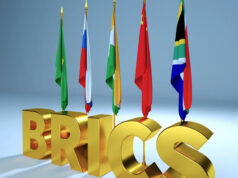Rajdeep And Sagarika made terrible statement against Arnab Goswami. Rajdeep And Sagarika both compared Arnab Goswami’s Republic TV with North Korea.
Rajdeep And Sagarika are known for their anti-hindu and anti-BJP comments.
Rajdeep Said:

But People insulted and thrashed him brutally



After this Sagarika Ghose also commented on Arnab Goswami’s Channel Republic TV. She Said:

Then she also got insulted by people on social media



Earlier Rajdeep Wrote this article against PM Modi:
Caste narratives expose inner fault lines in our hierarchical society and can easily spark off controversy. Last week, when Jai Ram Thakur was selected as the BJP’s Himachal Pradesh chief ministerial candidate, I tweeted about how nine of the 11 BJP chief ministers (excluding the north-east) now belong to upper castes. Predictably, the tweet raised an avalanche of protest. Since 280 characters on Twitter aren’t enough to make a nuanced argument on the divisive issue of caste, I deleted the tweet. Thakur, a five-time MLA and the son of a mason and a farmer may be a deserving choice, but is also a beneficiary of Himachal’s ‘Thakur-waad’ dominance with nearly half the ruling party MLAs belonging to the community. Indeed, my central argument is unshaken: Seventy years after independence, despite the push for a more ‘inclusive’ politics, we remain an upper caste- led polity.
When Narendra Modi became the country’s prime minister, it was seen as a watershed moment, one that would genuinely effect a change in the power pyramid. Until then, the highest executive post in the country was controlled by upper castes (the one exception was Deve Gowda, a Vokkaliga from Karnataka, whose brief tenure must be seen as an aberration). Modi skillfully played up his OBC credentials during the 2014 campaign, especially in the caste cauldron of north India. Mani Shankar Aiyar’s sneeringly snobbish ‘chaiwallah’ comment only gave Modi the space to affirm his credentials as someone who had risen from a low-caste, low-income background to challenge the Brahminical elite.
Three years later, that elite is still very much in power. Just take a look at the senior ministers in the Union cabinet: the all-powerful Cabinet Committee on Security, for example, is monopolised by Brahmins and Thakurs. The senior bureaucracy is also dominated by the upper castes. The Opposition is led by a Janeu-Dhari Hindu, as we were firmly reminded by the Congress during the Gujarat campaign. Yes, the President of India is a Dalit, but his tenure in Rashtrapati Bhavan is unlikely to lead to greater Dalit empowerment, just as a Pratibha Patil’s nomination hardly promoted women’s emancipation.
Truth is, the ‘Bahujan-isation’ of Indian politics has been an experiment fraught with risk. The rise of the Dravida parties in south India and the Dalit-Bahujan assertion in Maharashtra was preceded by a reformist social revolution that ensured a relatively smooth transition of political power. By contrast, the Mandal revolution of the late 1980s in north India led to greater Dalit-OBC representation in electoral politics but also witnessed a fierce upper caste backlash. Statistics now show that OBC representation in parliament has declined in the past decade to pre-Mandal levels of around 20% even as upper caste numbers have sharply risen to 44%.
The manner in which the BJP’s Hindutva wave swept aside narrow caste-based loyalties of the Samajwadi Party and Bahujan Samaj Party in Uttar Pradesh in 2017 could be a pointer to the future. Even after courting non-Yadav OBCs and non-Dalit Jatavs during the elections, the BJP chose a saffron-robed upper caste Thakur as its Hindutva mascot to lead the government. With the Yadav ‘parivar’ of UP and Bihar along with the BSP’s Mayawati typecast as a corrupt, self-aggrandising, family raj leadership, the BJP has tried to co-opt the disenchanted Mandal foot-soldiers — many of them from smaller, poorer communities — within a broader Hindu religious umbrella. The Congress too, is attempting to build a rival ‘rainbow’ coalition by aligning with a new generation of aggressive and articulate Dalit-Bahujan leaders like Jignesh Mevani while also embracing a Hardik Patel.
Neither the co-option nor the alignment may be smooth in every instance with dominant caste interests often clashing with the rest. The troubling events in Maharashtra this week where there was an attack on Dalits who were marking the 200th anniversary celebrations of a battle in which a British contingent comprising a sizeable number of Mahars (a Dalit sub caste) defeated the Peshwas reflects how old animosities are finding new expressions. Amid growing rural distress and economic inequities, influential agrarian caste protest movements have also surfaced amongst the Patidars in Gujarat, Marathas in Maharashtra and the Jats in Haryana, each pushing for a share in the reservation pie. Accommodating these powerful groups without alienating sizeable Dalit-Bahujan interests is now a big challenge for any major political force, one that could shape the future of post-Mandal politics.
Post-script: To those turned off by caste arithmetic in politics, how about a review of the matrimonial columns in newspapers that so glaringly mirror social prejudice? As for us journalists, we too maybe need to look within and ask the inconvenient question: how many Dalit, OBC, Adivasi editors do we have in Indian newsrooms?




